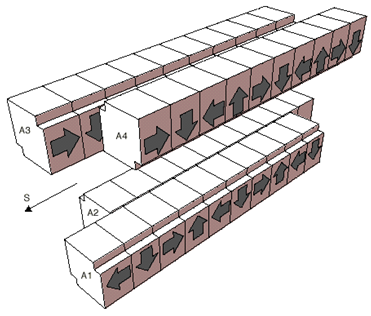Overview
ID32 is an intense source of polarized, highly monochromatic soft x-rays in the energy range from 400 eV to 1600 eV. It is principally used to probe the electronic structure and magnetism in a diverse range of systems using x-ray absorption and resonant scattering techniques. The energy range of the beamline covers the important L2,3 edges of the transition metal and M4,5 edges of the rare earth elements as well as the nitrogen and oxygen K edge. The beamline can deliver circularly as well as linearly polarised X-rays with polarisation rates close to 100%.
| End Stations | ||
| Other Information | ||
The beamline is equipped with:
- Three APPLE II undulators providing ~100% circular/linear beam polarization
- Three experimental areas: i High Field Magnet, ii RIXS, iii Open.
- UHV Sample Preparation Facilities attached to the high field magnet
- Plane grating monochromator with a resolving power of 5000 for the XMCD/Open branch and 42 000 (goal) for the RIXS branch
- Optics focusing down to 10 × 100 microns (FWHM) vertical × horizontal beam size and up to several square millimeters for the XMCD branch, and down to 4 × 60 microns (FWHM) vertical × horizontal beam size for the RIXS branch
We can also adapt to a variety of user experimental stations.
Scientific applications
The beamline is primarily used to investigate the magnetic and electronic properties of nanoclusters, ultrathin films, superconductors and semimetals with a variety of techniques. Magneto-optical effects are particularly strong in the soft x-ray range, and can be described relatively accurately.
The research on ID32 covers a wide range of magnetic phenomena, such as spin and orbit resolved magnetic moments, magnetic anisotropies, element specific magnetisation, domain walls etc. At the same time one can study the electronic structure of materials.
Techniques Available
X-ray magnetic circular dichroism (XMCD)
The XMCD signal is the difference in the absorption of light due to a reversal of the light polarization or magnetisation. Application of sum rules allows the determination of spin, orbital moments and their anisotropies. The strong advantages of this technique are the high sensitivity (<1% of a monolayer coverage) and the element selectivity. The low temperature superconducting magnet allows application of this technique to many different aspects of new magnetic phenomena (nanomagnetism, interface spin polarization, isolated atoms on surfaces... ).
Resonant Inelastic X-ray Scattering (RIXS)
RIXS is a second order optical process, in which an electron is excited from an occupied core state to an unoccupied state, and energy and momentum differences between these states are probed. The excitation of valence electrons in inelastic X-ray scattering is generally weak, thus resonance enhancement near the core excitation threshold is utilised in RIXS to distinguish this process, by setting the incident energy close to an absorption edge (excitation to a bound state). RIXS can be used to study charge, magnetic, lattice and orbital excitations. RIXS is a photon-in, photon-out technique. It's advantages are its bulk sensitivity (~100nm in the soft X-ray range), orbital and element specificity and it can be used to probe very small samples - even 1 unit cell thick.
Typically, the absorption edges probed with Soft X-ray RIXS are transition metal L2,3 edges (hv ≈ 400-1000eV) and rare earth M4,5 edges (hv ≈ 900-1500eV).
The newly constructed RIXS Spectrometer is now operational and being used for experiments.








